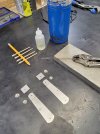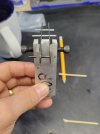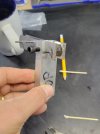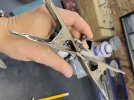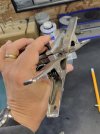First, clean the blade and bolster with fine sandpaper. Everything should be flat and the joints meet properly.
Wash very well with dish soap and rinse with hot water. Dry off with a paper towel and don't touch any place you want to solder with your fingers.
Apply the flux to both parts and place together. Only use light clamping pressure if you have to use clamps at all. I use soldering tweezers.
Slowly heat the bolster and blade until it reaches the melting point of the solder. A small flame is all you need. A heat gun also works well.
Apply the solder to the joint as the metals heat up and when it flows back off the heat a bit and apply a bit more solder. Don't heat the solder, heat the metal. If the solder starts to melt but doesn't want to flow, apply a little more flux to the joint. Again, don't heat the solder, heat the metal you want it to join. The flux should bubble and maybe turn white (on some types) but if it burns, STOP, and start over by sanding and cleaning the metal parts again. Too much heat is a problem, too little heat is almost impossible with most small torches. A plumbers propane torch is about 100 times too powerful for soldering a bolster. Those little cheap refillable butane torches online and at the hardware stores are prefect. They are not good for much else but lighting a cigar but work perfect for soldering with low temp solders.
Use the heat source to draw the solder through the joint. The solder will flow toward the heat.
Use a solder pick to make the solder run down all the joints. It is a pointed rod with a wooden or other handle. I use solder picks made from 16 gauge steel wire, brass, and titanium ones. All work fine. They just break any oxides and surface tension along the joint and allow the solder to flow. Also, make a solder graver from a piece of 1/4" brass rod or square stock. Grind the end into a diamond shape point that can be used to cut away excess solder along the joint. The brass will cut the solder easily, but won't scratch the blade or bolster.
Once the solder flows, remove the heat. Don't touch or move the job for at least two minutes. If you do you can easily get a crystalized solder joint that will fail. Once cooled off, wash well and clean up. Do all filing and sanding necessary. If you have to use the belt grinder or polish the object on a buffer, do it gently and do not let it get hot or you can unsolder the joint from the friction heat.

